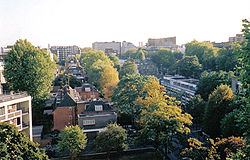Bayswater
| Bayswater | |
| Middlesex | |
|---|---|
 View across Bayswater towards Kensington Gardens | |
| Location | |
| Grid reference: | TQ255805 |
| Location: | 51°30’34"N, 0°11’34"W |
| Data | |
| Population: | 10,300 (2011) |
| Post town: | London |
| Postcode: | W2 |
| Dialling code: | 020 |
| Local Government | |
| Council: | Westminster |
| Parliamentary constituency: |
Cities of London and Westminster Westminster North |
Bayswater is an urban village in the depths of the metropolitan growth in Middlesex, on the west side of the Edgware Road, between Kensington Gardens to the south, Paddington to the north-east, and Notting Hill to the west, two and a half miles west of Charing Cross.
This is one of London's most cosmopolitan areas: a diverse local population is augmented by a high concentration of hotels. Notable ethnic groups include Malaysians, Greeks, French, Americans, Brazilians, Italians, Irish, Arabs, and many others.
The streets and garden squares are lined with Victorian stucco terraces, mostly now subdivided into flats and boarding houses. Properties range from apartments to small studio flats. There are also purpose-built apartment blocks dating from the inter-war period as well as more recent developments, and a large council estate, the 650-flat Hallfield Estate, designed by Sir Denys Lasdun and now largely sold off.
Queensway and Westbourne Grove are its busiest high streets, both having many international ethnic-cuisine restaurants.
Name
The name ‘Bayswater’ is derived from the 1380 placename "Bayards Watering Place", which indicates either a watering place for horses (‘bayards’), or a watering place belonging to the Bayard family.[1]
Places of interest
- Kensington Gardens
- St Sophia's Cathedral
- The Mitre, Bayswater
- Whiteleys Shopping Centre
References in fiction
- In John le Carré's The Spy Who Came in from the Cold, Liz is a member of the Bayswater South Branch of the Communist Party.
- In le Carré's Smiley's People, the retired Estonian general turned British spy, Vladimir, lives in a dingy flat on Westbourne Grove.
- Many of the characters in Samuel Selvon's novel The Lonely Londoners live in Bayswater.
- The Alfred Hitchcock film Frenzy was filmed in the area.
- In Martin Amis's Success, the two main characters live together in a flat in Bayswater, which he calls 'the district of transients.'
- In Oscar Wilde's The Importance of Being Earnest, Lady Bracknell indicates that the perambulator (carrying Jack, as a baby) was found "standing by itself in a remote corner of Bayswater".
- In Saki's short story "Cross Currents" (1909), Vanessa Pennington lives on a "Bayswater back street" but would have preferred "smarter surroundings."
- In Evelyn Waugh's novel Brideshead Revisited, Charles Ryder's father lives in Bayswater.
- Whiteleys is frequently seen in film, for example in Love Actually, Closer, and was referred to in My Fair Lady as Eliza Doolittle is sent "to Whiteleys to be attired" in Pygmalion. It also has Princess Productions' studios on the top floor.
- Scenes in Alfie (1966) were filmed around Chepstow Road.
- The main character in Iris Murdoch's novel A Word Child, Hilary Burde, has a "flatlet" near Bayswater Tube Station.
- Scenes in The Black Windmill refer to, and were filmed around, the area.
- In the Italian comics series Dylan Dog the main character lives in Craven Road.
- Nick Jenkins meets Uncle Giles for tea at the Ufford Hotel, "riding at anchor on the sluggish Bayswater tide", in The Acceptance World (1955), volume three of A Dance to the Music of Time by Anthony Powell.
- Linda Stratmann's novel The Poisonous Seed is set almost entirely in Victorian Bayswater.
- In Lauren Willig's Pink Carnation Series, her character Eloise Kelly lives in Bayswater while writing her doctoral thesis.
- In Herbert Jenkins' novel, Patricia Brent, Spinster, Patricia lives at Gavin House, a boarding house in Bayswater.
Outside links
| ("Wikimedia Commons" has material about Bayswater) |
References
- ↑ Mills, Anthony David: 'A Dictionary of British Place-Names' (Oxford University Press, 2003) ISBN 978-0-19-852758-9